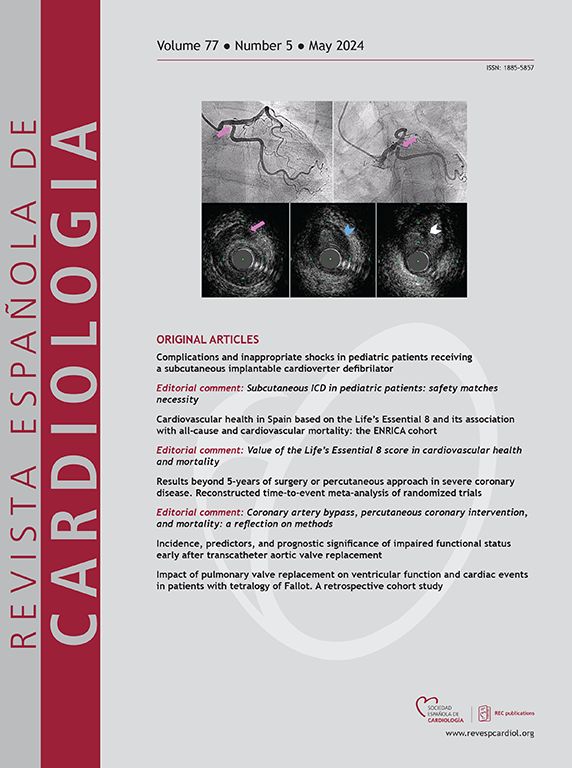Validación experimental de la gravedad de la estenosis coronaria y el desarrollo de miocardio isquémico
IF 5.9
2区 医学
Q2 Medicine
引用次数: 0
Abstract
Introduction and objectives
The current study aimed to evaluate the causal association between hemodynamically significant stenosis and the occurrence of ischemic myocardium using an experimental animal model of coronary artery stenosis.
Methods
In Yorkshire swine (n = 10), coronary stenosis in the left anterior descending artery was induced using a customized vascular occluder to create varying degrees of occlusion severity (40%-99%). Serial changes in coronary pressure and flow velocity were measured in the left anterior descending artery before and after the implantation of the vascular occluder. At 1 month, 13N-ammonia positron emission tomography (PET) was performed, followed by the collection of isolated hearts for 2,3,5-Triphenyltetrazolium chloride (TTC) staining to quantify the percent area of necrotic myocardium. Three animals in the control group were evaluated using the same protocols, but without the implantation of a vascular occluder.
Results
The median diameter stenosis after vascular occluder implantation was 61.3% (Q1-Q3: 55.9%-72.3%). Significant differences were observed in hyperemic stenosis resistance, fractional flow reserve (FFR), stress perfusion defect and reversibility in PET, as well as in necrotic myocardium in TTC staining based on stenosis severity (control group: < 50%, 50%-70%, 70%-90%, and > 90%) (all P < .010). Animals with FFR < 0.75 at 1 month exhibited a significantly higher area of stress perfusion defect (30.7 ± 3.1% vs 6.0 ± 4.2%, P < .001), reversibility in PET (11.0 ± 4.0% vs 0.0 ± 0.0%, P = .006), and necrotic myocardium in TTC staining (15.8 ± 6.4% vs 0.0 ± 0.0%, P < .001) than those with FFR ≥ 0.75.
Conclusions
In a porcine model, the induction of hemodynamically significant stenosis with FFR < 0.75 was associated with the development of stress perfusion defects and reversibility in PET, as well as necrotic myocardium identified by pathology.
冠状动脉狭窄和缺血性心肌发展严重程度的实验验证
本研究旨在通过冠状动脉狭窄的实验动物模型来评估血流动力学上显著的狭窄与缺血性心肌的发生之间的因果关系。方法选用约克郡猪(n = 10),采用定制血管闭塞器诱导左前降支冠状动脉狭窄,造成不同程度的闭塞程度(40% ~ 99%)。观察血管封堵器植入前后左前降支冠状动脉压力和血流速度的变化。1个月时进行13n -氨正电子发射断层扫描(PET),然后收集离体心脏进行2,3,5-三苯四唑氯(TTC)染色,量化坏死心肌的面积百分比。对照组的三只动物使用相同的方案进行评估,但没有植入血管闭塞器。结果血管闭塞器植入术后中位径狭窄率为61.3% (Q1-Q3: 55.9%-72.3%)。PET在充血性狭窄阻力、血流储备分数(FFR)、应激灌注缺损、可逆性以及基于狭窄严重程度的TTC染色坏死心肌中观察到显著差异(对照组:<;50%, 50%-70%, 70%-90%, >;90%)(全部P <;.010)。患有FFR的动物0.75组在1个月时表现出更高的应激灌注缺损面积(30.7±3.1% vs 6.0±4.2%),P <;.001), PET染色的可逆性(11.0±4.0% vs 0.0±0.0%,P = 0.006), TTC染色的坏死心肌(15.8±6.4% vs 0.0±0.0%,P <;.001)比FFR≥0.75者明显。结论在猪模型中,FFR和lt诱导血流动力学意义显著的狭窄;0.75与PET的应激灌注缺陷和可逆性的发展以及病理鉴定的坏死心肌相关。
本文章由计算机程序翻译,如有差异,请以英文原文为准。
求助全文
约1分钟内获得全文
求助全文
来源期刊

Revista espanola de cardiologia
医学-心血管系统
CiteScore
4.20
自引率
13.60%
发文量
257
审稿时长
28 days
期刊介绍:
Revista Española de Cardiología, Revista bilingüe científica internacional, dedicada a las enfermedades cardiovasculares, es la publicación oficial de la Sociedad Española de Cardiología.
 求助内容:
求助内容: 应助结果提醒方式:
应助结果提醒方式:


